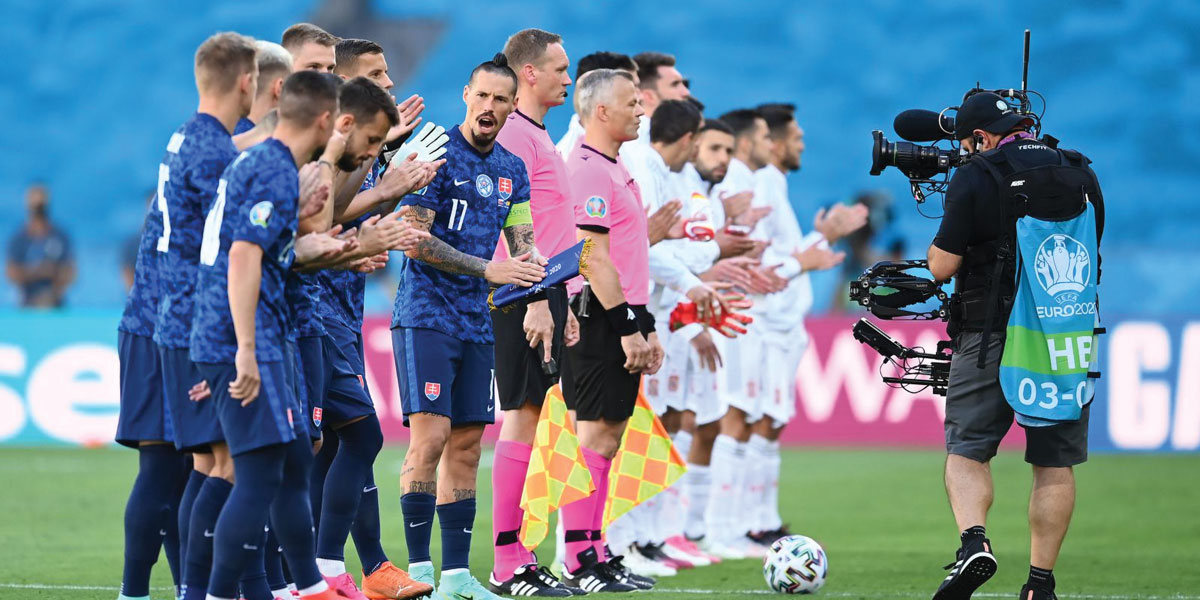Keeping Pirates off the Pitch

Posted on Dec 20, 2023 by FEED Staff
Content piracy is rife, especially in live sports. How can federations and broadcasters continue to stay one step ahead of the big steal?
Premium video production is complex, expensive and typically involves media rights deals for sports and other live content. If content is not protected in its delivery chain to the viewer, with proper authorisation and payment, stakeholders involved in the production find themselves facing uncontrollable leakage and potentially hefty financial loss through piracy.
Parks Associates estimates that, by the end of 2027, there will be a cumulative loss to piracy of $113 billion for streaming video providers serving US consumers. The forecast revealed piracy rates for US streaming services in film and television programming are expected to rise from 22% in 2022 to 24.5% in 2027.
As technology and internet connectivity have advanced, so too has piracy in the sports arena. Illegal streaming websites and unlicensed broadcasts have mushroomed, seemingly offering fans free access to live games and highlights. Piracy of course undermines revenue streams for leagues and clubs, including broadcasting rights deals, sponsorship agreements and merchandising – impacting player salaries, academy team development and infrastructure investment.
Tracking a moving target
Alvaro Jeanneau, the senior director of media rights management at New York and Mexico-based broadcaster TelevisaUnivision, says: “The first time we ever streamed sports content on digital was the 2010 Fifa World Cup at TelevisaUnivision. At the time, we were dealing with as many as ten unique hosting sites that were propagating infringing content.
“By 2014, we saw as many as 100 different hosting sites – some of them compliant and some extremely non-compliant,” he told a recent SportsPro Media conference session.
“But we know how this story goes: these sites keep popping up because pirates keep looking for the path of least resistance. And for Qatar 2022 we saw as many as 350 unique hosting sites, which really shows that the terrain is very fragmented in terms of people we are enforcing against. This represented a 3390% ten-year growth in the proliferation
of hosting sites.
“Frankly for us, it’s not about just thinking of piracy as a compliance matter, but there are some very good insights you can glean from piracy if you lean into the problem – and not just focus on whacking all the illegal streams we come across.”
“Looking at piracy from a compliance lens misses key information,” he adds. “For example, piracy can often give you hints as to where the market is going. Pirate consumers can be early adopters. Some of the jurisdictions we’re now chasing down are non-compliant, because pirates choose places where they know we’re not going to go after them. So it’s becoming increasingly difficult to mitigate this problem. But if we only come at it from a compliance lens then we’re missing incredibly important business intelligence that could otherwise be used to inform some critical decisions.”
It’s not just about beating pirates, it’s also about using the business intelligence gained from doing so to ensure you have the right product proposition in the right place at the right pricing – so that you can seek to convert those viewing pirate content into paying viewers.
On your watermarks
Blocking access to web servers carrying illegal content is one of the most common forms of supply-side content protection actions. This involves the blocking of access to pirate websites by internet service providers (ISPs), following any legal requirements that have been set out in a court order.
If live blocking legislation is not in place, or is not strong enough in a particularly territory, another piracy prevention tool is watermarking, which provides traceability back to the account to which pirated content was first delivered. Broadcasters or OTT service providers can then quickly disable an account that is being used to illegally rebroadcast live sporting events.
Forensic watermarking is invisible to the viewer, but is detectable by specialist technologies. It plays an important role in tackling sports piracy, as accounts used by dedicated pirates can be quickly identified and action taken.
Back in May this year, the European Commission issued a recommendation on combating online piracy of sports and live events. Following a 2021 European Parliament resolution on the challenges of sports events organisers in the digital environment, the European Commission launched preparatory work to assess the issues related to unauthorised retransmissions of live event broadcast.
As a result of this consultation, the European Commission decided to opt for a non-binding approach rather than a legislative instrument that the European Parliament and rightsholders were calling for. This non-legislative initiative is a toolbox to combat online piracy, which the EU member states, national authorities, holders of rights and providers of intermediary services are called upon to employ.
“The internet already enables European citizens to enjoy a variety of live events, from sports events to live concerts. However, commercial-scale piracy is jeopardising the viability of our creative and sports industries,” says Margrethe Vestager, executive vice president of A Europe Fit for the Digital Age.
“This is especially true in the case of live events, which generate most of their value during the real-time transmission. It is therefore essential that online intermediaries cooperate with live and sports event organisers as well as broadcasters to combat piracy of live events.”
SW19 content protection
This year, organisers of The Championships at Wimbledon strengthened their ability to quickly remove illegal broadcasts through a global agreement with Sportian [formerly LaLiga Tech]. Sportian’s Content Protection service carried out continuous monitoring and elimination of pirated content related to matches broadcast from the two weeks of The Championships. This monitoring was carried out across all search engines, social media sites, online marketplaces, IPTV services and apps from any location.
Content Protection tackled online piracy by scanning all channels where illegal content was being distributed or promoted, removing it and collecting evidence to streamline legal procedures. Its teams of analysts worked in collaboration with the world’s largest distribution platforms and social networks to ensure that illegal content was removed as quickly as it emerged.
“The illegal piracy of sports content is the scourge of our industry, and its protection for both licensors and rights-holding broadcasters is essential if we are to maintain a healthy and vibrant ecosystem,” asserts Guillermo Rodríguez, director at Content Protection.
Football ecosystem at risk
At IBC 2023, content protection supplier Friend MTS staged a fireside chat interview between operations director, Chris White, and senior anti-piracy expert at Uefa, Diego Dabrio. Uefa is the governing body for European football.
“For club competitions, we sell in cycles of three years, and for national team competitions it’s four years,” according to Dabrio. “In the 2021-2022 season, the amount that was distributed to European football (both to individual clubs and the national associations) from the revenues we generated by the selling of media rights was over €3 billion.
Uefa currently organises a total of 19 competitions, including the Champions League, the Women’s Champions League, the Nations League, Women’s Nations League and Under 21 competitions.
“Ultimately, we support the development and promotion of football at all levels down to the grassroots level. If piracy is left uncontrolled, it’s putting the whole football ecosystem at risk, not only the commercial model that we have in place but also this very important solidarity function. That’s why we take it extremely seriously.”
When it comes to Uefa’s anti-piracy operations, it has a sophisticated end-to-end system.
“In 2020, we ran an RFP process, and we appointed leaders in content protection,” expands Dabrio. “Friend MTS was appointed to cover all internet-based platforms during the 2021-2024 cycle.
“To protect live content, we have pre-match, in-match and post-match measures. We are looking for sources of illicit content before the match window to enforce upon it during the game. The post-match measures relate to social media in particular, where clips and highlights can be posted without permission.
“For match day enforcement, we are crawling, we have fingerprinting verification and we will enforce accordingly. We implement blocking orders that we have currently in the UK and the Republic of Ireland.
“The live window is key. Blocking orders are powerful in fighting piracy in real time. We need to build momentum for blocking orders to happen in all the territories.
“There is no system that is 100% effective against piracy,” says Dabrio. “It’s a combination of elements, putting measures in place, keeping an eye on what’s going on and what might happen in the future.”
Originally published in the Winter 2023 issue of FEED.











